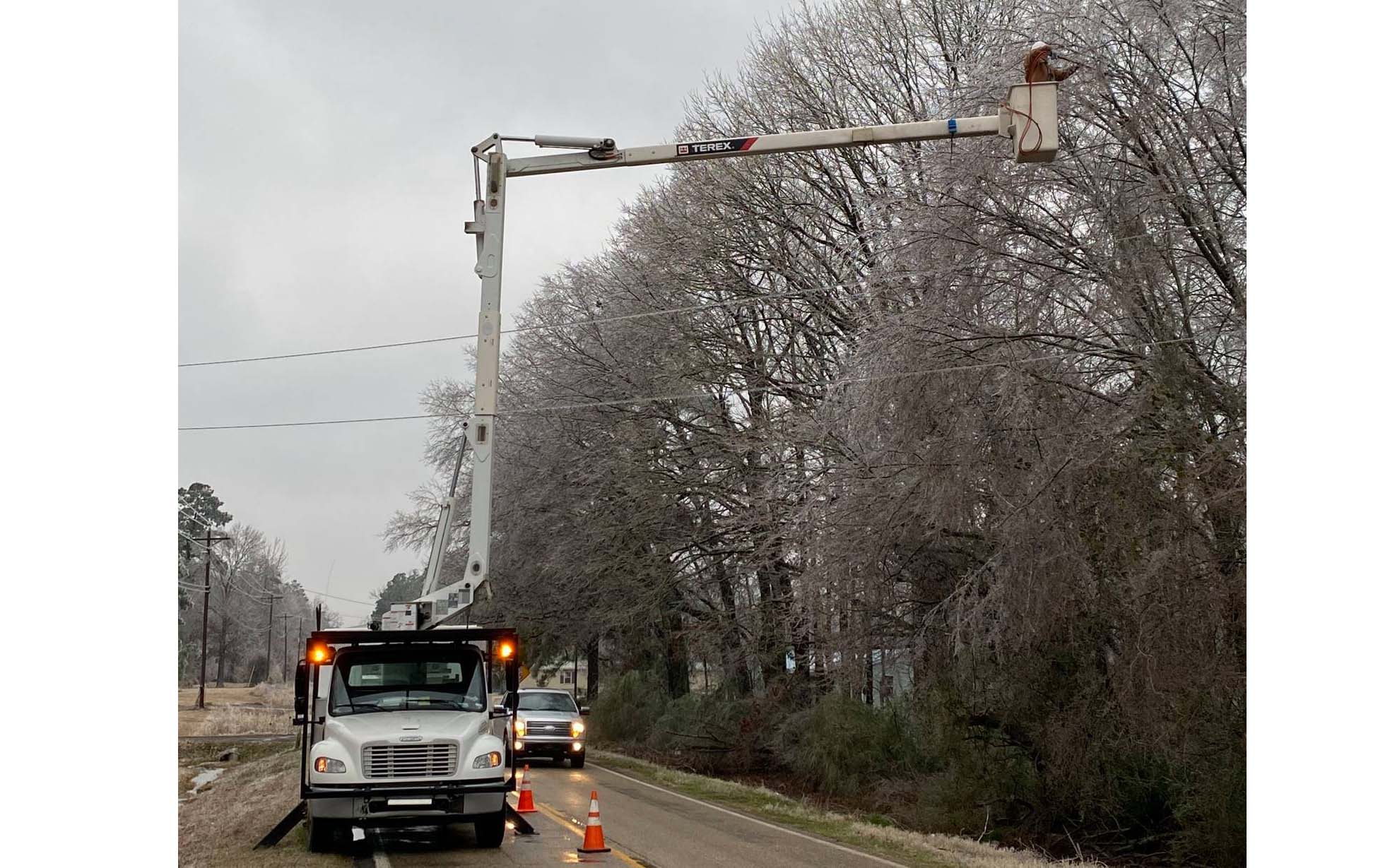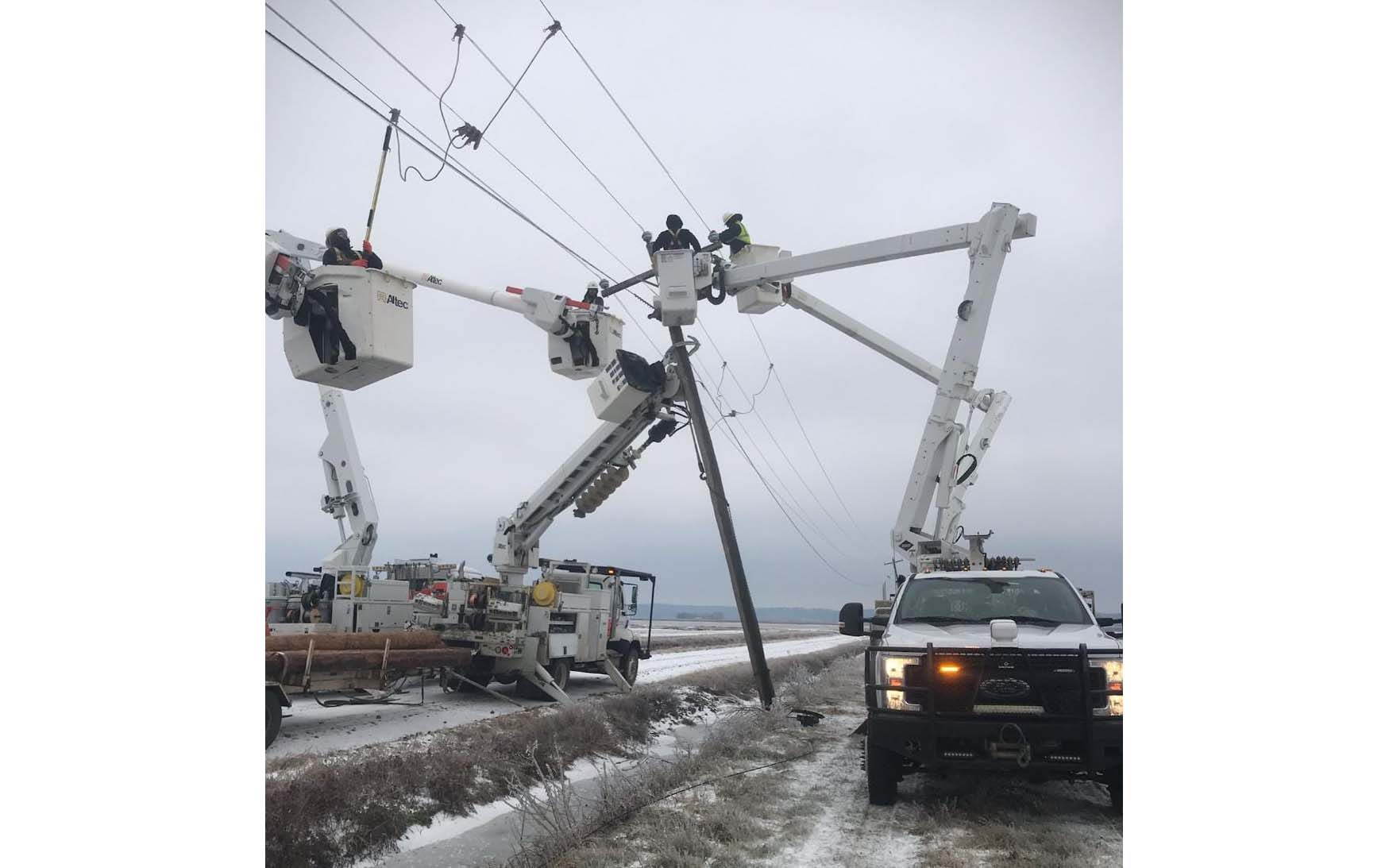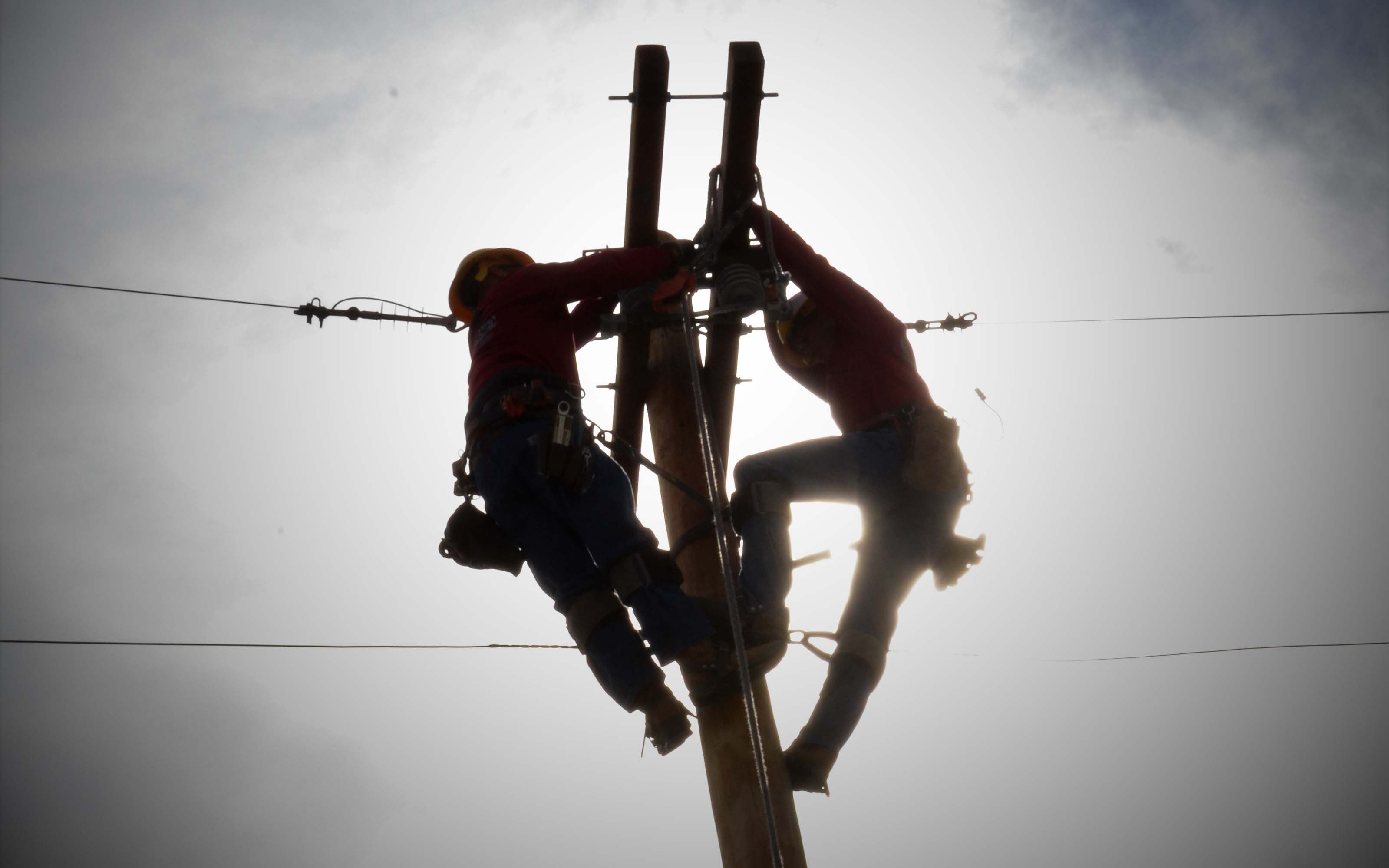Arkansas’ energy grid gets tested as winter storm blankets state
February 22-28, 2021
By Wesley Brown
Amid the winter storm that barreled into Arkansas more than 25 states last week, the nation got a glimpse into the nation’s aging and fragile energy grid as it struggles to keep pace with the increasing demands of the 21st Century and growing threats both near and far.
And as many Arkansans were mostly worried about staying warm and safe, the system that delivers electricity to millions of homes and businesses across the U.S. was perilously close to throwing most of the nation into the dark, according to the Federal Energy Regulation Commission (FERC).
And because Little Rock is home to Southwest Power Pool and the Midcontinent Independent System Operator (MISO), two of the nation’s largest grid operators, local command center operations here played a significant role in keeping the lights on across most of the U.S. In the U.S., SPP and MISO are among the nine regional transmission organizations (RTOs) and independent system operators (ISOs) that coordinate power use on the U.S. and North American energy grid.
For example, as weather reports of heavy snow across Arkansas, MISO issued an emergency alert on Valentine’s Day morning saying that it anticipated heavy energy demands due to sustained frigid temperatures and inclement weather. In that alert, the Carmel, Ind.-based ISO noted that the impact of winter weather would be widespread across MISO’s 15-state footprint and particularly harsh in the South Region, including most of Arkansas.
MISO said it would be working closely with its members, including Entergy Arkansas and its New Orleans-based parent, Entergy Corp, to maintain system reliability amid extreme conditions.
* * * *
Keeping the lights on
“The current load forecasts in the South Region are approaching an all-time winter peak of 32 GW in comparison to last year’s peak of 27 GW, making this a very difficult situation,” said Renuka Chatterjee, executive director of system operations at MISO. “We are in constant contact with our members and our partner ISO/RTOs to ensure the reliability of the bulk electric system.”
“Keeping the lights on requires a high level of coordination and collaboration with our members and the communities they serve,” added Daryl Brown, executive director of MISO South Region operations in West Little Rock. “Although we are experiencing unusual weather in the South, we are working together to meet that challenge.”
Across town in West Little Rock, SPP also issued an alert on President’s Day morning. Located adjacent to MISO, the Arkansas RTO manages electricity flow across 60,000 miles of high-voltage transmission lines in 14 central and western U.S. states.
That Monday morning, SPP declared an Energy Emergency Alert (EEA) Level 2, which requires the Arkansas RTO to direct its member companies and utilities to issue public conservation appeals. Under FERC rules, EEA2 is the second of three EEA levels. An EEA3 would be triggered if SPP needed to utilize operating reserves below the required minimum or ask our members to implement controlled service interruptions.
Later that day, as heavy snow began blanketing most of SPP’s West-leaning grid system, SPP declared an Energy Emergency Alert (EEA) Level 3, signaling that its operating reserves were below the required minimum. At the time, SPP directed its member utilities to be prepared to implement controlled interruptions of service if necessary.
“Controlled service interruptions are a last resort, and a step we take only when necessary to safeguard continued reliability of the regional grid,” said Lanny Nickell, SPP’s COO and longtime grid expert.
By Tuesday noon (Feb. 16), MISO had also declared an EEA 3 “Max Gen Event’’ for the South Region, which included most of Entergy Corp’s operating subsidiaries in Arkansas, Louisiana, Mississippi, and Southeast Texas. The declaration directed all utilities and so-called “load balancing authorities’’ in the affected areas to implement periodic power outages.
By this time, MISO and all its members made public appeals for residential and commercial electricity uses to conserve power across the South Region. MISO also said it was working closely with neighboring reliability grip operators like SPP to understand their conditions and provide mutual assistance where possible.
“MISO and its members continue to closely monitor the developing weather conditions across the footprint and must take necessary actions to protect the grid,” said Brown. “Controlled outages are always a last resort effort and necessary to maintain reliability.”
By Wednesday, MISO announced it had managed multiple interdependent issues, including transmission constraints and generation outages. “In a situation where so many issues are showing up simultaneously, you have to prioritize the challenges to preserve overall grid reliability,” said Chatterjee from her home office in the Indianapolis metropolitan area. “We will continue to work with our members and neighboring reliability coordinators to navigate a very complex and dynamic situation.”
MISO said it had also issued several emergency declarations, which resulted in temporary power interruptions in parts of Southeast Texas, Southwest/South-Central Louisiana, and South-Central Illinois. Most of those outages have now been restored, it said.
As a nod to MISO, Entergy Arkansas on Tuesday and Wednesday also asked its 700,000 in 63 of Arkansas 75 counties to voluntarily reduce their electricity usage amid the winter storm, especially between 5-9 p.m. In a news release from Arkansas’ largest electricity provider, Entergy Arkansas said its current load forecasts were approaching an all-time peak, even greater than those experienced during the polar vortex of January 2019.
Noting the MISO “Max Gen” directive, Entergy Arkansas also warned if the power supply could meet the demand, periodic power outages would be needed to prevent extensive outages that could last an extended period.
“We apologize for any inconvenience this request may cause, but the extreme temperatures for consecutive days are driving up electricity usage, warned Kurt Castleberry, director of Entergy Arkansas’ resource planning and market operations. “This is an unusual situation driven by extreme weather conditions much of the country is experiencing. We are working to respond and bring the electric system back to a normal operational state as soon as possible.”
By late Tuesday evening, Entergy Arkansas stated that it temporarily instituted “mandatory rolling outages” for some customers. “We’re not out of the woods yet, so please continue to conserve energy,” Entergy Arkansas spokeswoman Brandi Hinkle.
Earlier in the day, SPP also upgraded to an EEA Level 3 alert, announcing that its system-wide generating capacity had dropped below 42 gigawatts (GW) due to extremely low temperatures and inadequate natural gas supplies.
“We’ll be working with our member utilities to implement controlled interruptions of electric service throughout our region. This is done as a last resort to preserve the reliability of the electric system as a whole,” said SPP. “Individuals in the SPP service territory should take steps to conserve energy use and follow their local utilities’ instructions regarding conservation, local conditions and the potential for outages to their homes and businesses.”
By Wednesday, both SPP and MISO had ended load reduction across their respective regions. However, weather forecasters were already predicting another round of winter storms later in the week and upcoming days. So far, Entergy Arkansas has escaped any severe or prolonged outages for the 2.9 million utility customers it delivers electricity to in Arkansas, Louisiana, Mississippi, and Texas.
In addition to Entergy Arkansas, Little Rock-based Arkansas Electric Cooperatives Corp. (AECC) was also forced to implement emergency contingency plans that included short-term, rotating power curtailments at some local electric cooperatives. AECC is the wholesale power provider for the state’s 17 rural electric cooperatives, serving more than 500,000 customers in Arkansas and surrounding states.
“This unprecedented situation is related to a number of factors, including a very volatile natural gas market, lack of dispatchable power generation resources and the extremely cold weather across multiple states,” said Andrew Lachowsky, vice president of planning and market operations for the Electric Cooperatives of Arkansas. “Despite public appeals to reduce usage and working with large industrial members, Arkansas’ electric cooperatives were forced to implement the short-term curtailment plan in order to avoid major wholesale power delivery issues.”
Altogether, Gov. Asa Hutchinson said 18,000 to 20,000 Arkansans were still without electricity early Tuesday afternoon after the state was hit with nearly a foot of snow and temperatures well below zero in some areas. At the Daily Record press deadline on Thursday, weather forecasters were predicting more wintry weather over the weekend.
* * * *
Energy investigations and upgrades
Meanwhile, Texas and federal energy regulators are asking for an investigation of the Electric Reliability Council of Texas (ERCOT), the Austin-based grid operator for most of the Alamo State. Late Tuesday evening, there were still more than 3 million Texans without electricity as 45,000 megawatts of ERCOT’s power were still offline.
That same evening, Texas Gov. Greg Abbott called on that state’s legislature to investigate ERCOT, saying the nation’s second-most populous state had experienced power outages on the scale never seen.
“The Electric Reliability Council of Texas has been anything but reliable over the past 48 hours,” said Abbott. “Far too many Texans are without power and heat for their homes as our state faces freezing temperatures and severe winter weather. This is unacceptable. Reviewing the preparations and decisions by ERCOT is an emergency item so we can get a full picture of what caused this problem and find long-term solutions.”
In Washington, D.C., FERC and the North American Electric Reliability Corp. also announced on Feb. 16 that they would open a joint inquiry into the bulk-power system’s operations during the extreme winter weather conditions experienced by the Midwest and South-central states.
In the coming ahead, FERC and NERC said they would formally begin the inquiry, working with other federal agencies, states, regional entities, and utilities to identify problems with the bulk-power system’s performance and, where appropriate, solutions for addressing those issues.
“The Commission is in contact with ERCOT, SPP and MISO – as the regions served by these grid operators have been particularly hard hit by record cold and wintry precipitation,” said FERC Chairman Rich Glick. “Safeguarding the reliability of the bulk power system is paramount and I have directed FERC staff to coordinate closely with the RTOs/ISOs, utilities, NERC, and regional reliability entities to do what we can to help. “
And although Entergy provides electricity to 461,000 customers in parts of southeast Texas, MISO canceled its order for power outages in the region. Shortly after, Entergy Arkansas and Entergy Texas began restoring customers affected by these outages back to service.
It has now been more than eight years since Entergy Corp. completed the integration of its transmission system into MISO. As a part of that historic pact, MISO’s board of directors approved a $2.7 billion expansion plan across the grid operator’s 15-state footprint in 2015, including $170 million in investments that will upgrade Arkansas’ aging electricity infrastructure.
For its part, SPP’s board of directors announced a new expansion and electricity storage plan at the RTO’s annual meeting just over a year ago. Those approved plans include a long list of transmission projects in the SPP region, including 78 projects estimated to cost $545 million that will be constructed over the next six years in eight states. In 2019, SPP’s member companies completed 39 transmission system upgrades in eight states at an estimated $190 million cost.
In late 2018, the Federal Energy Regulatory Commission said more than $5 billion of transmission upgrades had been completed by six of the nation’s nine RTO/ISO markets. That FERC report to Congress noted that infrastructure investments might help relieve grid congestion.
As recently as 2019, a bipartisan bill in the U.S. Senate to upgrade U.S. infrastructure includes $80 billion in energy grid upgrades and improvements. That legislation also looks to defend the U.S. energy system from increasing cyberattacks by foreign actors by partnering with private industry to remove vulnerabilities that could allow hackers to access the grid through holes in digital software systems.
In late September, MISO and SPP announced they would collaborate on a year-long transmission study designed to identify transmission projects with comprehensive, cost-effective, and efficient upgrades. Both RTOs said they are looking for solutions to historical challenges facing generation interconnection customers in areas where their boundaries connect, also known as seams.
This joint study will focus on solutions that the RTOs believe will offer benefits to their interconnection customers and end-use consumers of RTO member companies. While MISO and SPP said they have an existing joint operating agreement that allows them to work through reliability issues, existing processes do not include the simultaneous evaluation of benefits or cost allocation to both load and interconnection customers.
“A fundamental issue facing grid transformation is the lack of transmission at requested connection points,” said SPP President and CEO Barbara Sugg. “Working together, MISO and SPP can target those areas where there are mutual benefits on both sides of our seams.”
“Our member companies and stakeholders have told us that we need a better solution that prioritizes projects that address these gaps,” added John Bear, chief executive at MISO. “Collaborating in this way gives us the opportunity to explore potential improvements within our own interconnection processes while informing longer-term regional transmission planning efforts in both MISO and SPP.”
The study was expected to kick off in December 2020 and will include several joint stakeholder meetings to provide informational updates on the findings. v
PHOTOS: (Photos from AECC)
Crews for the Arkansas Electric Cooperative Corp. (AECC), the wholesale power provider for the state’s 17 local electric cooperatives, go to work to restore power across the state.





